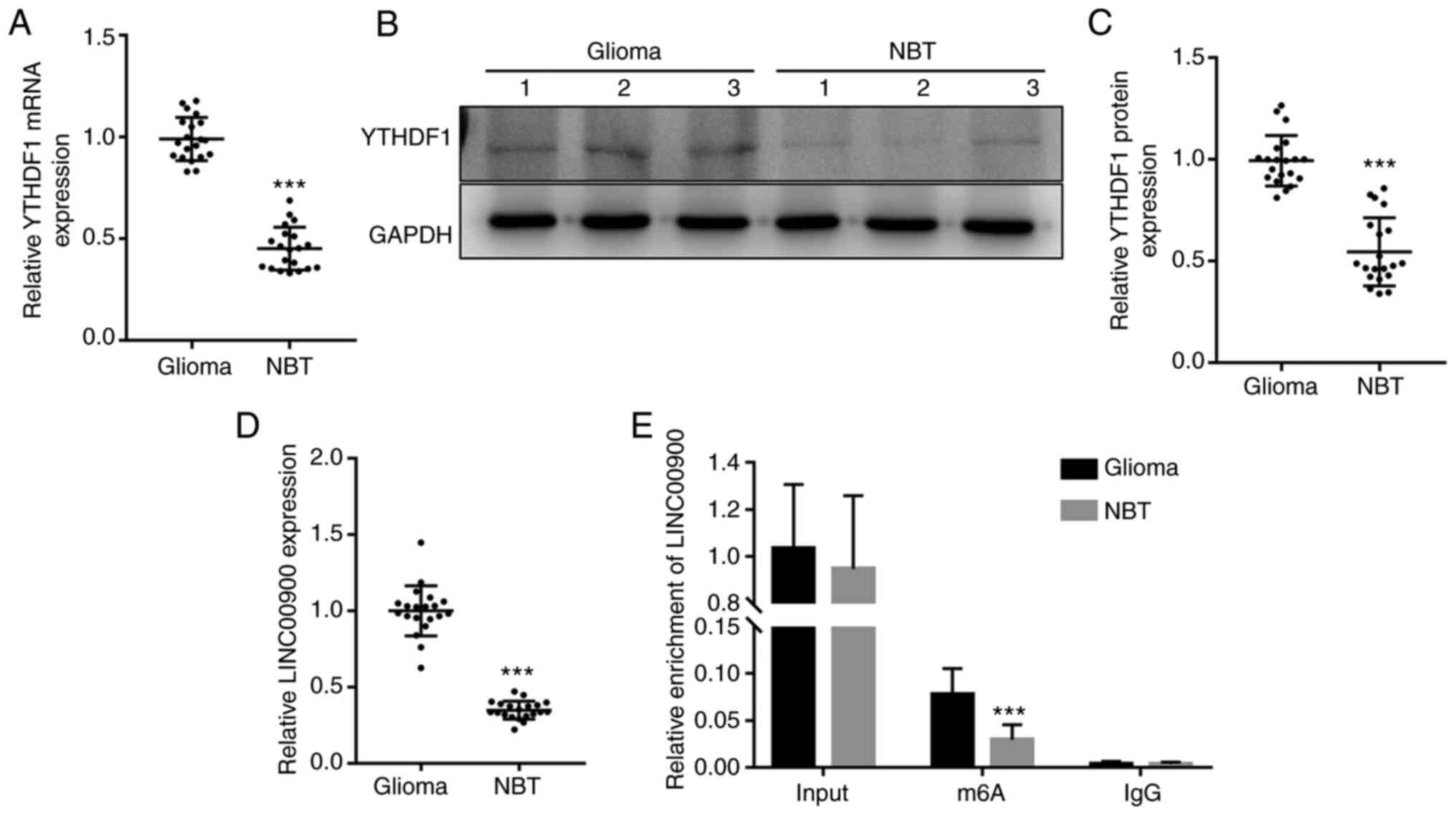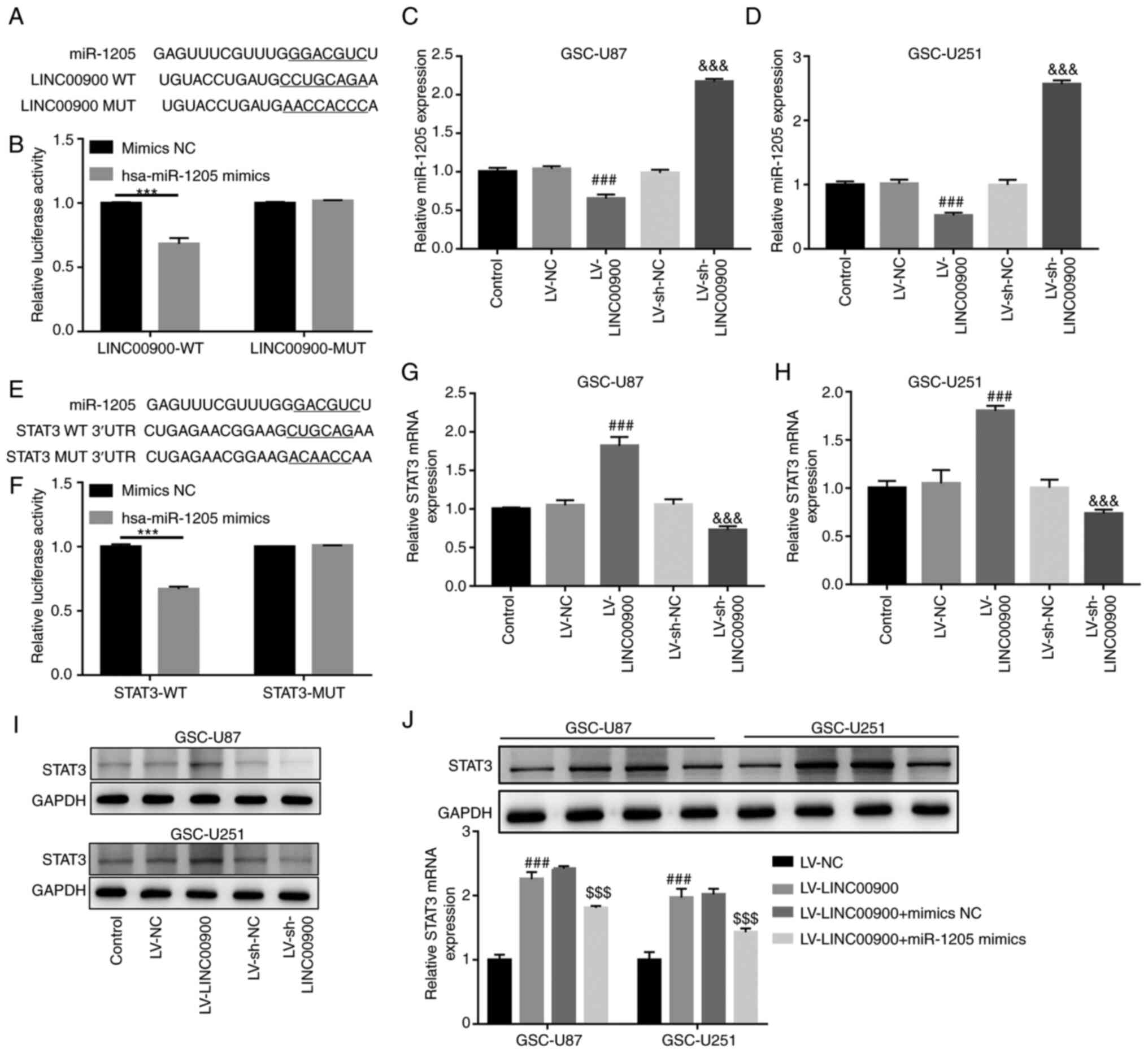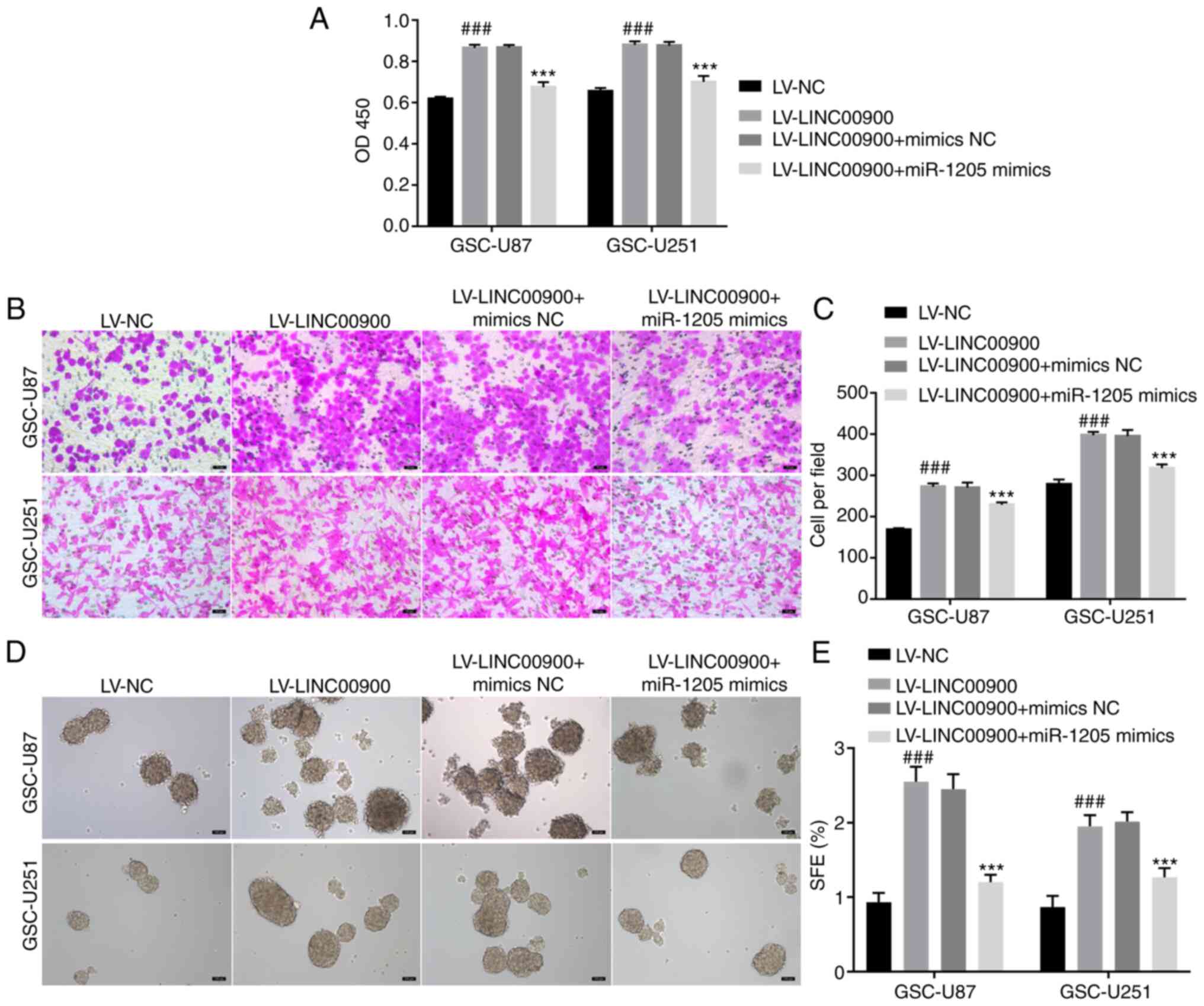|
1
|
Xu S, Tang L, Li X, Fan F and Liu Z:
Immunotherapy for glioma: Current management and future
application. Cancer Lett. 476:1–12. 2020. View Article : Google Scholar : PubMed/NCBI
|
|
2
|
Rong L, Li N and Zhang Z: Emerging
therapies for glioblastoma: Current state and future directions. J
Exp Clin Cancer Res. 41:1422022. View Article : Google Scholar : PubMed/NCBI
|
|
3
|
Ma Q, Long W, Xing C, Chu J, Luo M, Wang
HY, Liu Q and Wang RF: Cancer stem cells and immunosuppressive
microenvironment in glioma. Front Immunol. 9:29242018. View Article : Google Scholar
|
|
4
|
Zhao LY, Song J, Liu Y, Song CX and Yi C:
Mapping the epigenetic modifications of DNA and RNA. Protein Cell.
11:792–808. 2020. View Article : Google Scholar : PubMed/NCBI
|
|
5
|
Fu Y, Dominissini D, Rechavi G and He C:
Gene expression regulation mediated through reversible
m6A RNA methylation. Nat Rev Genet. 15:293–306. 2014.
View Article : Google Scholar : PubMed/NCBI
|
|
6
|
Du J, Ji H, Ma S, Jin J, Mi S, Hou K, Dong
J, Wang F, Zhang C, Li Y and Hu S: m6A regulator-mediated
methylation modification patterns and characteristics of immunity
and stemness in low-grade glioma. Brief Bioinform. 22:bbab0132021.
View Article : Google Scholar : PubMed/NCBI
|
|
7
|
Tao N, Wen T, Li T, Luan L, Pan H and Wang
Y: Interaction between m6A methylation and noncoding RNA in glioma.
Cell Death Discov. 8:2832022. View Article : Google Scholar : PubMed/NCBI
|
|
8
|
Cui Q, Shi H, Ye P, Li L, Qu Q, Sun G, Sun
G, Lu Z, Huang Y, Yang CG, et al: m(6)A RNA methylation regulates
the self-renewal and tumorigenesis of glioblastoma stem cells. Cell
Rep. 18:2622–2634. 2017. View Article : Google Scholar : PubMed/NCBI
|
|
9
|
Visvanathan A, Patil V, Arora A, Hegde AS,
Arivazhagan A, Santosh V and Somasundaram K: Essential role of
METTL3-mediated m(6)A modification in glioma stem-like cells
maintenance and radioresistance. Oncogene. 37:522–533. 2018.
View Article : Google Scholar
|
|
10
|
Shi J, Zhang P, Dong X, Yuan J, Li Y, Li
S, Cheng S, Ping Y, Dai X and Dong J: METTL3 knockdown promotes
temozolomide sensitivity of glioma stem cells via decreasing MGMT
and APNG mRNA stability. Cell Death Discov. 9:222023. View Article : Google Scholar : PubMed/NCBI
|
|
11
|
You J, Tao B, Peng L, Peng T, He H, Zeng
S, Han J, Chen L, Xia X, Yang X and Zhong C: Transcription factor
YY1 mediates self-renewal of glioblastoma stem cells through
regulation of the SENP1/METTL3/MYC axis. Cancer Gene Ther.
30:683–693. 2023. View Article : Google Scholar
|
|
12
|
Sun Y, Dong D, Xia Y, Hao L, Wang W and
Zhao C: YTHDF1 promotes breast cancer cell growth, DNA damage
repair and chemoresistance. Cell Death Dis. 13:2302022. View Article : Google Scholar : PubMed/NCBI
|
|
13
|
He Y, Wang W, Xu X, Yang B, Yu X, Wu Y and
Wang J: Mettl3 inhibits the apoptosis and autophagy of chondrocytes
in inflammation through mediating Bcl2 stability via
Ythdf1-mediated mA modification. Bone. 154:1161822022. View Article : Google Scholar
|
|
14
|
Lin Z, Niu Y, Wan A, Chen D, Liang H, Chen
X, Sun L, Zhan S, Chen L, Cheng C, et al: RNA m A methylation
regulates sorafenib resistance in liver cancer through
FOXO3-mediated autophagy. EMBO J. 39:e1031812020. View Article : Google Scholar
|
|
15
|
Liu T, Wei Q, Jin J, Luo Q, Liu Y, Yang Y,
Cheng C, Li L, Pi J, Si Y, et al: The m6A reader YTHDF1 promotes
ovarian cancer progression via augmenting EIF3C translation.
Nucleic Acids Res. 48:3816–3831. 2020. View Article : Google Scholar : PubMed/NCBI
|
|
16
|
Wang S, Gao S, Zeng Y, Zhu L, Mo Y, Wong
CC, Bao Y, Su P, Zhai J, Wang L, et al: N6-Methyladenosine reader
YTHDF1 promotes ARHGEF2 translation and RhoA signaling in
colorectal cancer. Gastroenterology. 162:1183–1196. 2022.
View Article : Google Scholar
|
|
17
|
Deng X, Sun X, Hu Z, Wu Y, Zhou C, Sun J,
Gao X and Huang Y: Exploring the role of m6A methylation regulators
in glioblastoma multiforme and their impact on the tumor immune
microenvironment. FASEB J. 37:e231552023. View Article : Google Scholar : PubMed/NCBI
|
|
18
|
Yarmishyn AA, Yang YP, Lu KH, Chen YC,
Chien Y, Chou SJ, Tsai PH, Ma HI, Chien CS, Chen MT and Wang ML:
Musashi-1 promotes cancer stem cell properties of glioblastoma
cells via upregulation of YTHDF1. Cancer Cell Int. 20:5972020.
View Article : Google Scholar : PubMed/NCBI
|
|
19
|
Jiang MC, Ni JJ, Cui WY, Wang BY and Zhuo
W: Emerging roles of lncRNA in cancer and therapeutic
opportunities. Am J Cancer Res. 9:1354–1366. 2019.PubMed/NCBI
|
|
20
|
Meyer KD, Saletore Y, Zumbo P, Elemento O,
Mason CE and Jaffrey SR: Comprehensive analysis of mRNA methylation
reveals enrichment in 3′ UTRs and near stop codons. Cell.
149:1635–1646. 2012. View Article : Google Scholar : PubMed/NCBI
|
|
21
|
Huang H, Weng H and Chen J: M(6)a
modification in coding and non-coding RNAs: Roles and therapeutic
implications in cancer. Cancer Cell. 37:270–288. 2020. View Article : Google Scholar : PubMed/NCBI
|
|
22
|
Liu P, Fan B, Othmane B, Hu J, Li H, Cui
Y, Ou Z, Chen J and Zu X: m6A-induced lncDBET promotes the
malignant progression of bladder cancer through FABP5-mediated
lipid metabolism. Theranostics. 12:6291–6307. 2022. View Article : Google Scholar :
|
|
23
|
Li ZX, Zheng ZQ, Yang PY, Lin L, Zhou GQ,
Lv JW, Zhang LL, Chen F, Li YQ, Wu CF, et al: WTAP-mediated
m6A modification of lncRNA DIAPH1-AS1 enhances its
stability to facilitate nasopharyngeal carcinoma growth and
metastasis. Cell Death Differ. 29:1137–1151. 2022. View Article : Google Scholar : PubMed/NCBI
|
|
24
|
Wang W, Li J, Lin F, Guo J and Zhao J:
Identification of N(6)-methyladenosine-related lncRNAs for patients
with primary glioblastoma. Neurosurg Rev. 44:463–470. 2021.
View Article : Google Scholar
|
|
25
|
Liu H, Xu Y, Yao B, Sui T, Lai L and Li Z:
A novel N6-methyladenosine (m6A)-dependent fate decision for the
lncRNA THOR. Cell Death Dis. 11:6132020. View Article : Google Scholar : PubMed/NCBI
|
|
26
|
Wu W, Klockow JL, Zhang M, Lafortune F,
Chang E, Jin L, Wu Y and Daldrup-Link HE: Glioblastoma multiforme
(GBM): An overview of current therapies and mechanisms of
resistance. Pharmacol Res. 171:1057802021. View Article : Google Scholar : PubMed/NCBI
|
|
27
|
Livak KJ and Schmittgen TD: Analysis of
relative gene expression data using real-time quantitative PCR and
the 2(-Delta Delta C(T)) method. Methods. 25:402–408. 2001.
View Article : Google Scholar
|
|
28
|
Zhang G, Zheng P, Lv Y, Shi Z and Shi F:
m6A regulatory gene-mediated methylation modification in glioma
survival prediction. Front Genet. 13:8737642022. View Article : Google Scholar : PubMed/NCBI
|
|
29
|
Chang YZ, Chai RC, Pang B, Chang X, An SY,
Zhang KN, Jiang T and Wang YZ: METTL3 enhances the stability of
MALAT1 with the assistance of HuR via m6A modification and
activates NF-κB to promote the malignant progression of
IDH-wildtype glioma. Cancer Lett. 511:36–46. 2021. View Article : Google Scholar : PubMed/NCBI
|
|
30
|
Zhang S, Zhao BS, Zhou A, Lin K, Zheng S,
Lu Z, Chen Y, Sulman EP, Xie K, Bögler O, et al: m(6)A demethylase
ALKBH5 maintains tumorigenicity of glioblastoma stem-like cells by
sustaining FOXM1 expression and cell proliferation program. Cancer
Cell. 31:591–606.e596. 2017. View Article : Google Scholar : PubMed/NCBI
|
|
31
|
Chai RC, Chang YZ, Chang X, Pang B, An SY,
Zhang KN, Chang YH, Jiang T and Wang YZ: YTHDF2 facilitates UBXN1
mRNA decay by recognizing METTL3-mediated m(6)A modification to
activate NF-κB and promote the malignant progression of glioma. J
Hematol Oncol. 14:1092021. View Article : Google Scholar
|
|
32
|
Xu C, Yuan B, He T, Ding B and Li S:
Prognostic values of YTHDF1 regulated negatively by mir-3436 in
glioma. J Cell Mol Med. 24:7538–7549. 2020. View Article : Google Scholar : PubMed/NCBI
|
|
33
|
Zaccara S and Jaffrey S: A unified model
for the function of YTHDF proteins in regulating mA-modified mRNA.
Cell. 181:1582–1595.e1518. 2020. View Article : Google Scholar
|
|
34
|
Zou Z, Sepich-Poore C, Zhou X, Wei J and
He C: The mechanism underlying redundant functions of the YTHDF
proteins. Genome Biol. 24:172023. View Article : Google Scholar : PubMed/NCBI
|
|
35
|
Cong P, Wu T, Huang X, Liang H, Gao X,
Tian L, Li W, Chen A, Wan H, He M, et al: Identification of the
role and clinical prognostic value of target genes of m6A RNA
methylation regulators in glioma. Front Cell Dev Biol.
9:7090222021. View Article : Google Scholar : PubMed/NCBI
|
|
36
|
Liu G, Li H, Ji W, Gong H, Jiang Y, Ji G
and Liu G: Construction of a ceRNA network in glioma and analysis
of its clinical significance. BMC Genomics. 22:7222021. View Article : Google Scholar : PubMed/NCBI
|
|
37
|
Mu M, Niu W, Zhang X, Hu S and Niu C:
LncRNA BCYRN1 inhibits glioma tumorigenesis by competitively
binding with miR-619-5p to regulate CUEDC2 expression and the
PTEN/AKT/p21 pathway. Oncogene. 39:6879–6892. 2020. View Article : Google Scholar : PubMed/NCBI
|
|
38
|
Fu C, Li D, Zhang X, Liu N, Chi G and Jin
X: LncRNA PVT1 facilitates tumorigenesis and progression of glioma
via regulation of miR-128-3p/GREM1 axis and BMP signaling pathway.
Neurotherapeutics. 15:1139–1157. 2018. View Article : Google Scholar : PubMed/NCBI
|
|
39
|
Wang J, Li T and Wang B: Circ-UBAP2
functions as sponges of miR-1205 and miR-382 to promote glioma
progression by modulating STC1 expression. Cancer Med.
10:1815–1828. 2021. View Article : Google Scholar : PubMed/NCBI
|
|
40
|
Xiong J, Wang T, Tang H, Lv Z and Liang P:
Circular RNA circMAN2B2 facilitates glioma progression by
regulating the miR-1205/S100A8 axis. J Cell Physiol.
234:22996–23004. 2019. View Article : Google Scholar : PubMed/NCBI
|
|
41
|
Ma Z, Ma J, Lang B, Xu F, Zhang B and Wang
X: Circ_0001982 up-regulates the expression of E2F1 by adsorbing
miR-1205 to facilitate the progression of glioma. Mol Biotechnol.
65:466–476. 2023. View Article : Google Scholar
|
|
42
|
Yang M, Li G, Fan L, Zhang G, Xu J and
Zhang J: Circular RNA circ_0034642 elevates BATF3 expression and
promotes cell proliferation and invasion through miR-1205 in
glioma. Biochem Biophys Res Commun. 508:980–985. 2019. View Article : Google Scholar
|
|
43
|
Hirano T, Ishihara K and Hibi M: Roles of
STAT3 in mediating the cell growth, differentiation and survival
signals relayed through the IL-6 family of cytokine receptors.
Oncogene. 19:2548–2556. 2000. View Article : Google Scholar : PubMed/NCBI
|
|
44
|
Zou S, Tong Q, Liu B, Huang W, Tian Y and
Fu X: Targeting STAT3 in cancer immunotherapy. Mol Cancer.
19:1452020. View Article : Google Scholar : PubMed/NCBI
|
|
45
|
Lee H, Jeong AJ and Ye SK: Highlighted
STAT3 as a potential drug target for cancer therapy. BMB Rep.
52:415–423. 2019. View Article : Google Scholar : PubMed/NCBI
|
|
46
|
Sun X, Wang J, Huang M, Chen T, Chen J,
Zhang F, Zeng H, Xu Z and Ke Y: STAT3 promotes tumour progression
in glioma by inducing FOXP1 transcription. J Cell Mol Med.
22:5629–5638. 2018. View Article : Google Scholar : PubMed/NCBI
|
|
47
|
Wang H, Tao Z, Feng M, Li X, Deng Z, Zhao
G, Yin H, Pan T, Chen G, Feng Z, et al: Dual PLK1 and STAT3
inhibition promotes glioblastoma cells apoptosis through MYC.
Biochem Biophys Res Commun. 533:368–375. 2020. View Article : Google Scholar : PubMed/NCBI
|
















